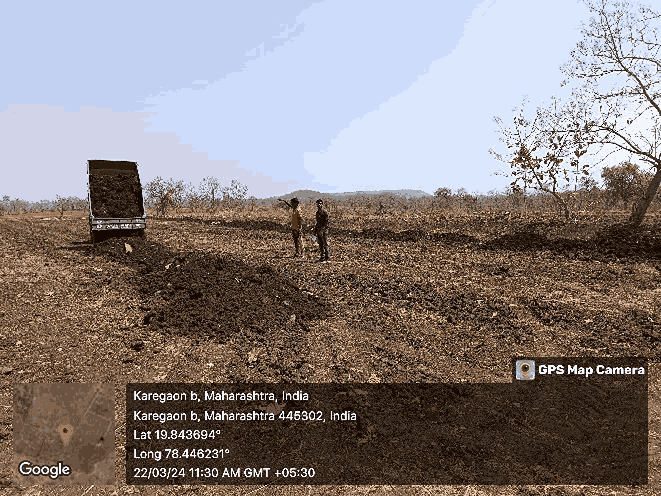Case Study : Tank Silt Application for Soil and Crop Productivity Enhancement
In the serene village Karegaon B of Pandharkawada Taluka, Mr Vikesh Pochhareddy Kondawar, age 35 years resides. Mr. Vikesh epitomizes the spirit of hard work and dedication, tending to his land with unwavering commitment. His educational journey led him through the corridors of knowledge until the 10th Standard, where he gleaned the fundamentals that would serve him well in his agrarian pursuits. Standing steadfast by his side is his wife, Radhika V. Kondawar, a woman of resilience and grace, whose educational path extended upto 12th Standard, complementing Vikesh endeavours with her own wisdom. Together, they form a formidable team, nurturing not just crops but a family bound by love and mutual support. Their son is, now 4 years old and her daughter is 6 years old. His daughter is studying in the first class. As the Kondawar family navigates the ebb and flow of rural life, their story embodies the timeless values of perseverance, education, and the enduring spirit of familial unity.
Mr Vikesh is a member in Jay Shree Ram Ulavaraham Purush Bachat gat Farmer Group. In the past 3 months, Vikesh has found a new sense of community and purpose as a proud member of Jay Shree ram, a farmers group dedicated to collective progress and empowerment. Through this association, Vikesh has not only cultivated his crops but also nurtured his savings habits, setting aside Rs. 100 each month towards a brighter financial future. Joining Jay Shree Ram has been more than just a financial endeavour for Vikesh, it's been a journey of personal growth
Through active participation, he has honed his communication skills, shedding any shyness or hesitation in expressing his thoughts and feelings. He attributes this newfound confidence to the supportive environment fostered within the group, where every voice is heard and valued.
Grateful for the support he has received, Vikesh acknowledges the invaluable credit facilities extended to him by the group. The farmers' group has not only provided financial assistance but has also served as a hub of knowledge and resources, connecting Vikesh to various facilities and opportunities for agricultural development.
In addition to the benefits derived from Jay Shree Ram, Vikesh highlights the significant contributions of the DHAN Foundation in enhancing agricultural practices and livelihoods. Through their various initiatives and activities, Vikesh has gained access to valuable resources, training, and support, empowering him to optimize his agricultural productivity and sustainability.
Karegaon (B) is a Tribal village located in Pandharkawada Taluka of Yavatmal District. Karegaon (B) thrives as a rural community deeply rooted in agriculture. For the majority of its inhabitants, agriculture serves as the primary source of income, shaping the rhythm of daily life and the annual cycles of sowing and harvesting. Sorghum, cotton, red gram, and various vegetable crops flourish in the fertile soil, sustaining both livelihoods and traditions. All these crop residues are serving as a vital nourishment for the local cattle population. It's worth noting that a significant proportion of farmers in this region belong to the rainfed category, relying heavily on seasonal rains to nurture their crops and sustain their agricultural pursuits. In this dynamic ecosystem, the resilience and resourcefulness of the farming community are evident, as they navigate the challenges and opportunities inherent in rainfed agriculture. In this agricultural land Vikesh have mostly arid land; he doesn’t get more yield in his farm. In this village, the tank was desilted and the tank silt was applied to the agricultural fields including to the field owned by Vikesh. This tank was formed in 1971 by government. It has more of silt deposited in the last 50 years. As that way of desiltation of tank and silt application to the direct farmers field each of the farmer including Vikesh got 25 tractor loads of tank silt from the tank.
Vikesh spreaded the silt to his agricultural field. He has 3.5 acres land and he applied silt to the field. He is happy in getting silt and now he tells it will be good for healthy crop yield. Because, silt of the tank is too much good for crops. To this tank, silt comes from the the farmers land and got deposited in the tank over the period of last 50 years. This silt got decomposed which is good for crops for getting more yield from the less farm. In Karegon (B) village, tank was given to 57 farmers. They are happy to get the tank silt.
Normal crop yield before tank silt application is as follows ;
| Crops | Yield per acre |
|---|---|
| Cotton | 7 Quintal |
| Red gram | 4 Quintal |
| Sorghum | 3 Quintal |
Expected crop yield after silt application is as follows ;
| Crops | Yield per acre |
|---|---|
| Cotton | 8 Quintal |
| Red gram | 5 Quintal |
| Sorghum | 4 Quintal |
The effect from the applied silt would available for more than five years and the cost involved in tank silt transportation would be covered by the savings in fertiliser use for the crop in this year, Vikesh says.

Savings on Fertilizer Application :
Before tank silt Application : 3 bags of 10:26:26 and 4 bags of 20:20: 0:13
After tank silt Application : 1.5 bags of 10:26:26 and 3 bags of urea.